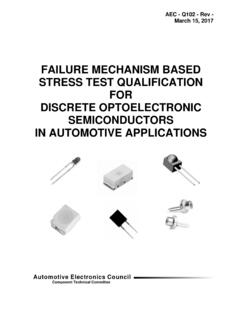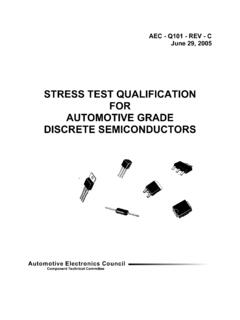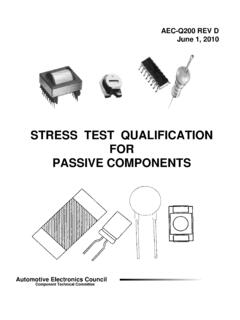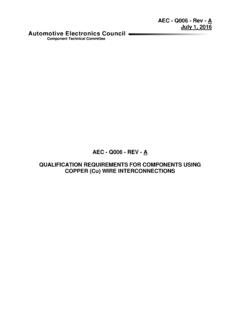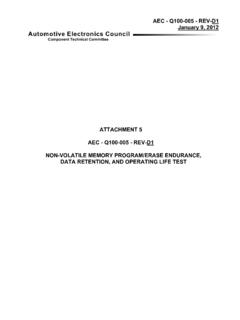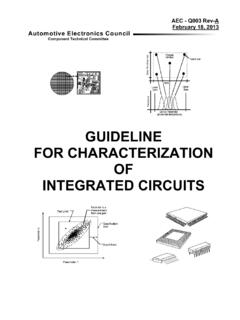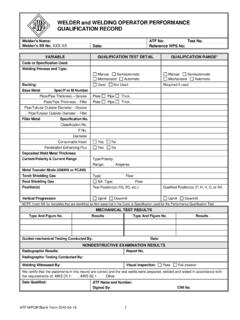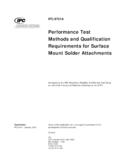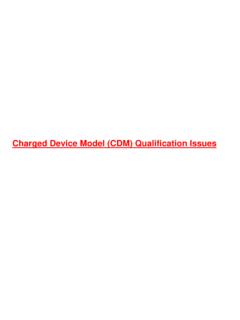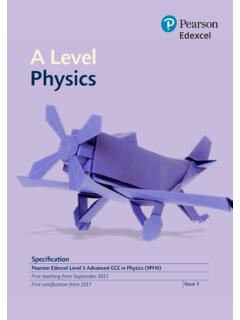Transcription of FAILURE MECHANISM BASED STRESS TEST QUALIFICATION …
1 AEC - Q100 - Rev-G. May 14, 2007. FAILURE MECHANISM BASED . STRESS TEST QUALIFICATION . FOR. INTEGRATED CIRCUITS. Automotive Electronics Council Component Technical Committee AEC - Q100 - REV-G. May 14, 2007. Automotive Electronics Council Component Technical Committee TABLE OF CONTENTS. AEC-Q100 FAILURE MECHANISM BASED STRESS Test QUALIFICATION for Integrated Circuits Appendix 1: Definition of a QUALIFICATION Family Appendix 2: Q100 Certification of Design, Construction and QUALIFICATION Appendix 3: Plastic Package Opening for Wire Bond Testing Appendix 4: Minimum Requirements for QUALIFICATION Plans and Results Appendix 5: Part Design Criteria to Determine Need for EMC Testing Appendix 6: Part Design Criteria to Determine Need for SER Testing Attachments AEC-Q100-001: WIRE BOND SHEAR TEST. AEC-Q100-002: HUMAN BODY MODEL (HBM) ELECTROSTATIC DISCHARGE (ESD) TEST. AEC-Q100-003: MACHINE MODEL (MM) ELECTROSTATIC DISCHARGE (ESD) TEST.
2 AEC-Q100-004: IC LATCH-UP TEST. AEC-Q100-005: NONVOLATILE MEMORY WRITE/ERASE ENDURANCE, DATA RETENTION, AND OPERATIONAL LIFE TEST. AEC-Q100-006: ELECTRO-THERMALLY INDUCED PARASITIC GATE LEAKAGE (GL) TEST. AEC-Q100-007: FAULT SIMULATION AND TEST GRADING. AEC-Q100-008: EARLY LIFE FAILURE RATE (ELFR). AEC-Q100-009: ELECTRICAL DISTRIBUTION ASSESSMENT. AEC-Q100-010: SOLDER BALL SHEAR TEST. AEC-Q100-011: CHARGED DEVICE MODEL (CDM) ELECTROSTATIC DISCHARGE (ESD). TEST. AEC-Q100-012: SHORT CIRCUIT RELIABILITY CHARACTERIZATION OF SMART POWER. DEVICES FOR 12V SYSTEMS. AEC - Q100 - REV-G. May 14, 2007. Automotive Electronics Council Component Technical Committee Acknowledgment Any document involving a complex technology brings together experience and skills from many sources. The Automotive Electronics Council would especially like to recognize the following significant contributors to the revision of this document: Sustaining Members: Mark A.
3 Kelly Delphi Corporation Jean Clarac Siemens VDO. Brian Jendro Siemens VDO. Hadi Mehrooz Siemens VDO. Robert V. Knoell Visteon Corporation Associate Members: Guest Members: Tim Haifley Altera David Locker AMRDEC. Daniel Vanderstraeten AMI Semiconductor Jeff Jarvis AMRDEC. Earl Fischer Autoliv Mike Klucher Cirrus Logic Xin Miao Zhao Cirrus Logic John Timms Continental Automotive Systems Roy Ozark Continental Automotive Systems Nick Lycoudes Freescale Kenton Van Klompenberg Gentex Werner Kanert Infineon Technologies Elfriede Geyer Infineon Technologies John Bertaux International Rectifier Gary Fisher Johnson Controls Tom Lawler Lattice Semiconductor Sohail Malik Lattice Semiconductor Scott Daniels Maxim Tom Tobin Maxim Mike Buzinski Microchip Rob Horton Microchip Annette Nettles NEC Electronics Masamichi Murase NEC Electronics Zhongning Liang NXP Semiconductors Mark Gabrielle ON Semiconductor Ken Berry Renesas Technology Bruce Townsend Spansion Adam Fogle Spansion Brian Mielewski STMicroelectronics James Williams Texas Instruments Diana Siddall Texas Instruments Anca Voicu Xilinx Other Contributors.
4 Lewis Venters Cirrus Logic Peter Kowalczyk Delphi Corporation Joe Wurts Maxim Don Pecko Xilinx AEC - Q100 - REV-G. May 14, 2007. Automotive Electronics Council Component Technical Committee NOTICE. AEC documents contain material that has been prepared, reviewed, and approved through the AEC Technical Committee. AEC documents are designed to serve the automotive electronics industry through eliminating misunderstandings between manufacturers and purchasers, facilitating interchangeability and improvement of products, and assisting the purchaser in selecting and obtaining with minimum delay the proper product for use by those other than AEC. members, whether the standard is to be used either domestically or internationally. AEC documents are adopted without regard to whether or not their adoption may involve patents or articles, materials, or processes. By such action AEC does not assume any liability to any patent owner, nor does it assume any obligation whatever to parties adopting the AEC documents.
5 The information included in AEC. documents represents a sound approach to product specification and application, principally from the automotive electronics system manufacturer viewpoint. No claims to be in Conformance with this document shall be made unless all requirements stated in the document are met. Inquiries, comments, and suggestions relative to the content of this AEC document should be addressed to the AEC Technical Committee on the link Published by the Automotive Electronics Council. This document may be downloaded free of charge, however AEC retains the copyright on this material. By downloading this file, the individual agrees not to charge for or resell the resulting material. Printed in the All rights reserved Copyright 2007 by Delphi, Siemens VDO, and Visteon Corporation. This document may be freely reprinted with this copyright notice. This document cannot be changed without approval from the AEC Component Technical Committee.
6 AEC - Q100 - REV-G. May 14, 2007. Automotive Electronics Council Component Technical Committee FAILURE MECHANISM BASED STRESS TEST QUALIFICATION . FOR PACKAGED INTEGRATED CIRCUITS. Text enhancements and differences made since the last revision of this document are shown as underlined areas. Several figures and tables have also been revised, but changes to these areas have not been underlined. 1. SCOPE. This document contains a set of FAILURE MECHANISM BASED STRESS tests and defines the minimum STRESS test driven QUALIFICATION requirements and references test conditions for QUALIFICATION of integrated circuits (ICs). These tests are capable of stimulating and precipitating semiconductor device and package failures. The objective is to precipitate failures in an accelerated manner compared to use conditions. This set of tests should not be used indiscriminately. Each QUALIFICATION project should be examined for: a.
7 Any potential new and unique FAILURE mechanisms. b. Any situation where these tests /conditions may induce failures that would not be seen in the application. c. Any extreme use condition and/or application that could adversely reduce the acceleration. Use of this document does not relieve the IC supplier of their responsibility to meet their own company's internal QUALIFICATION program. In this document, "user" is defined as all customers using a device qualified per this specification. The user is responsible to confirm and validate all QUALIFICATION data that substantiates conformance to this document. Supplier usage of the device temperature grades as stated in this specification in their part information is strongly encouraged. Purpose The purpose of this specification is to determine that a device is capable of passing the specified STRESS tests and thus can be expected to give a certain level of quality/reliability in the application.
8 Reference Documents Current revision of the referenced documents will be in effect at the date of agreement to the QUALIFICATION plan. Subsequent QUALIFICATION plans will automatically use updated revisions of these referenced documents. Automotive AEC-Q001 Guidelines for Part Average Testing AEC-Q002 Guidelines for Statistical Yield Analysis AEC-Q003 Guidelines for Characterizing the Electrical Performance AEC-Q004 Zero Defects Guideline (DRAFT). SAE J1752/3 Integrated Circuits Radiated Emissions Measurement Procedure Military MIL-STD-883 Test Methods and Procedures for Microelectronics Page 1 of 32. AEC - Q100 - REV-G. May 14, 2007. Automotive Electronics Council Component Technical Committee Industrial JEDEC JESD-22 Reliability Test Methods for Packaged Devices EIA/JESD78 IC Latch-Up Test UL-STD-94 tests for Flammability of Plastic materials for parts in Devices and Appliances IPC/JEDEC J-STD-020 Moisture/Reflow Sensitivity Classification for Plastic Integrated Circuit Surface Mount Devices JESD89 Measurement and Reporting of Alpha Particle and Terrestrial Cosmic Ray-Induced Soft Errors in Semiconductor Devices JESD89-1 System Soft Error Rate (SSER) Test Method JESD89-2 Test Method For Alpha Source Accelerated Soft Error Rate JESD89-3 Test Method for Beam Accelerated Soft Error Rate Definitions AEC Q100 QUALIFICATION Successful completion and documentation of the test results from requirements outlined in this document allows the supplier to claim that the part is AEC Q100 qualified.
9 The supplier, in agreement with the user, can perform QUALIFICATION at sample sizes and conditions less stringent than what this document requires. However, that part cannot be considered AEC Q100 qualified until such time that the unfulfilled requirements can be completed. Approval for Use in an Application "Approval" is defined as user approval for use of a part in their application. The user's method of approval is beyond the scope of this document. Definition of Part Operating Temperature Grade The part operating temperature grades are defined below: Grade 0: -40 C to +150 C ambient operating temperature range Grade 1: -40 C to +125 C ambient operating temperature range Grade 2: -40 C to +105 C ambient operating temperature range Grade 3: -40 C to +85 C ambient operating temperature range Grade 4: 0 C to +70 C ambient operating temperature range 2. GENERAL REQUIREMENTS.
10 Objective The objective of this specification is to establish a standard that defines operating temperature grades for integrated circuits BASED on a minimum set of QUALIFICATION requirements. Page 2 of 32. AEC - Q100 - REV-G. May 14, 2007. Automotive Electronics Council Component Technical Committee Zero Defects QUALIFICATION and some other aspects of this document are a subset of, and contribute to, the achievement of the goal of Zero Defects. Elements needed to implement a zero defects program can be found in AEC-Q004 Zero Defects Guideline. Precedence of Requirements In the event of conflict in the requirements of this standard and those of any other documents, the following order of precedence applies: a. The purchase order b. The individual device specification c. This document d. The reference documents in section of this document e. The supplier's data sheet For the device to be considered a qualified part per this specification, the purchase order and/or the individual device specification cannot waive or detract from the requirements of this document.
